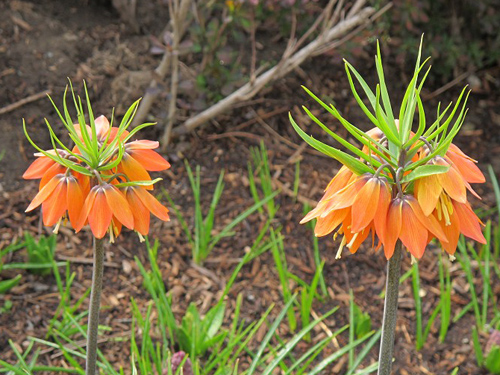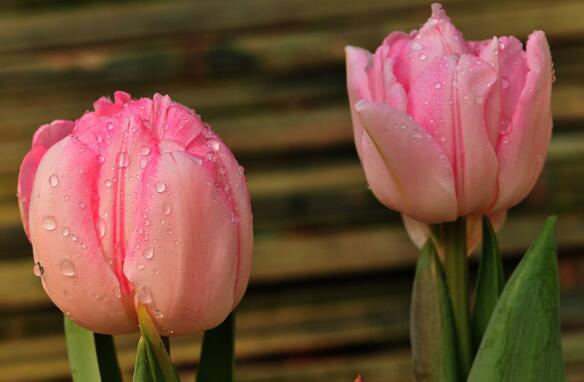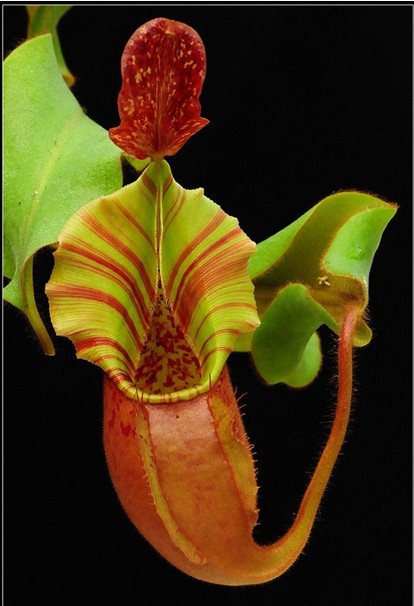Introduction and cultivation and Management techniques of Fritillaria thunbergii (Crown Fritillaria, Lilium)
Fritillaria thunbergii (Crown Fritillaria, lily)
Scientific name: fritillaria imperialis
Families and genera: Fritillaria of Liliaceae
Morphological features: the bulb is large. Stems erect, leaves ovate-lanceolate to lanceolate, entire. The plant bears several flowers, and the Corolla is bell-shaped, pendulous under leafy bracts. The flowers are bright red, orange and yellow.
Ecological habits: positive, shade-tolerant, cold-tolerant, requiring low temperature treatment of 5-9 degrees Celsius, about 13-17 weeks, growth temperature 7-20 degrees Celsius. Soil should be moist, good drainage, summer dormancy, ball storage, storage temperature of about 13 degrees Celsius, summer the Autumn Equinox ball reproduction.
Cultivation and management: choose sandy loam with loose and fertile, rich in organic matter, good drainage and ph6.0~7.5, apply sufficient base fertilizer before planting, mature organic fertilizer or fish and bone meal can be used; pot culture should use humus soil, garden soil and sand mixed substrate. The suitable planting time is from September to October in autumn, the distance between plants is about 30 cm, and the soil cover is 8 cm ~ 12 cm after planting. Areas with cold climate need to be covered for overwintering. After the new buds are unearthed in early spring, topdressing should be applied once in time to promote the growth of stems and leaves. Keep the soil moist at ordinary times, and the flowering varieties in late spring have better shade quality. After the aboveground withered in summer, the soil can be left in the dormant period, but the soil should not be too wet to avoid underground bulb rot, or it can be dug up and stored in a cool and ventilated environment for summer. Bulb rot occurs occasionally, in addition to disinfecting the bulb, Bordeaux solution can also be sprayed regularly to control it.
Pest control: it is vulnerable to leaf spot disease and lily black weevil during growth, which can be controlled by spraying 50% Topchin wettable powder 700 times 800 times and 140% omethoate EC 1000 times respectively.
Flowering: may.
Flower language: majesty.
Garden uses: garden planting, flower border, basic planting, dwarf varieties suitable for potted plants.
Medicinal efficacy: bulbs and flowers are used in medicine, resolving phlegm and relieving cough, clearing heat and dispersing knots.

Fritillaria thunbergii (Crown Fritillaria, lily)
Scientific name: Fritillaria imperialis
Families and genera: Fritillaria of Liliaceae
Morphological features: the bulb is large. Stems erect, leaves ovate-lanceolate to lanceolate, entire. The plant bears several flowers, and the Corolla is bell-shaped, pendulous under leafy bracts. The flowers are bright red, orange and yellow.
Ecological habits: positive, shade-tolerant, cold-tolerant, requiring low temperature treatment of 5: 9 ℃, about 13-17 weeks, growth temperature 7-20 ℃. The soil should be moist, the drainage is good, dormancy in summer, ball collection storage, storage temperature is about 13 ℃, the Autumn Equinox ball reproduction in summer.
Cultivation and management: choose sandy loam with loose and fertile, rich in organic matter, good drainage and pH6.0~7.5, apply sufficient base fertilizer before planting, mature organic fertilizer or fish and bone meal can be used; pot culture should use humus soil, garden soil and sand mixed substrate. The suitable planting time is from September to October in autumn, the distance between plants is about 30cm, and the soil is covered with 8cm~12cm after planting. Areas with cold climate need to be covered for overwintering. After the new buds are unearthed in early spring, topdressing should be applied once in time to promote the growth of stems and leaves. Keep the soil moist at ordinary times, and the flowering varieties in late spring have better shade quality. After the aboveground withered in summer, the soil can be left in the dormant period, but the soil should not be too wet to avoid underground bulb rot, or it can be dug up and stored in a cool and ventilated environment for summer. Bulb rot occurs occasionally, in addition to disinfecting the bulb, Bordeaux solution can be sprayed regularly to prevent and cure it.
Pest control: vulnerable to leaf spot disease and lily black weevil during growth, 50% topazine wettable powder 700 times 800 times and 140% omethoate EC 1000 times can be sprayed respectively.
Flowering: may.
Flower language: majesty.
Garden uses: garden planting, flower border, basic planting, dwarf varieties suitable for potted plants.
Medicinal efficacy: bulbs and flowers are used in medicine, resolving phlegm and relieving cough, clearing heat and dispersing knots.
Fritillaria imperalis Fritillaria thunbergii how to raise Fritillaria thunbergii how to reproduce Fritillaria thunbergii Fritillaria imperalis alias: bulb lily, crown Fritillaria classification: bulbous flower genus: plant kingdom angiosperm phylum Liliaceae Fritillaria is in full bloom: spring and summer Fritillaria is perennial bulb flower, autumn planting bulb. Fresh bulb is larger, plant height is about 70 cm; stem erect, leaves ovate-lanceolate to lanceolate, entire. The plant bears flowers, several flowers are collected, and the Corolla is bell-shaped, pendulous under a group of leafy bracts. The flowers are bright red, orange and yellow, and the florescence is from March to June. For planting Fritillaria, we should choose sandy loam with loose and fertile, rich in organic matter, good drainage and pH6.0-7.5. before planting, we should apply sufficient base fertilizer, mature organic fertilizer or fish and bone meal, and pot culture should use humus soil, garden soil and sand mixed substrate. Fritillaria plants are traditionally cultivated as medicinal materials in China. But in. The introduction of Fritillaria thunbergii is a perennial bulb flower and autumn bulb. Fresh bulb is larger, plant height is about 70 cm; stem erect, leaves ovate-lanceolate to lanceolate, entire. The plant bears flowers, several flowers are collected, and the Corolla is bell-shaped, pendulous under a group of leafy bracts. The flowers are bright red, orange and yellow, and the florescence is from March to June. For planting Fritillaria, we should choose sandy loam with loose and fertile, rich in organic matter, good drainage and pH6.0-7.5. before planting, we should apply sufficient base fertilizer, mature organic fertilizer or fish and bone meal, and pot culture should use humus soil, garden soil and sand mixed substrate. Fritillaria plants are traditionally cultivated as medicinal materials in China. But in the world, there are nearly a hundred species cultivated as ornamental flowers. Fritillaria thunbergii is one of the most famous and common species. The morphological characteristics of Fritillaria thunbergii is perennial bulb flower, fresh bulb is larger, plant height is about 70 cm; stem erect, leaves ovate-lanceolate to lanceolate, entire. The plant bears flowers, several flowers are collected, and the Corolla is bell-shaped, pendulous under a group of leafy bracts. The flowers of Fritillaria thunbergii are bright red, orange and yellow with a florescence in May. Another wave period Fritillaria (F.persica) plant height of 80 cm, long spikes, flowering in early summer, can be used as a flower border. Fritillaria thunbergii, also known as F.michailovskyi, is 20 cm tall with thin, gray-green leaves and small, bell-shaped, drooping flowers. The bulb has 2-3 fleshy scales, 1.5~4cm in diameter. Leaves sessile, broadly linear, 3-4 leaves whorled or opposite, apically bearded. Raceme, with 1-6 flowers, born in the axils of stem top leaves, bell-shaped, yellowish to yellowish green, with purple reticulate markings, drooping. The florescence is from March to June. The ecological habit of Fritillaria thunbergii is positive, shade-tolerant and cold-tolerant, which requires low temperature treatment of 5: 9 ℃, about 13-17 weeks, and the growth temperature is 7-20 ℃. The soil should be moist, the drainage is good, dormancy in summer, ball collection storage, storage temperature is about 13 ℃, the Autumn Equinox ball reproduction in summer. The cultivation techniques of Fritillaria thunbergii should choose sandy loam with loose and fertile, rich in organic matter, good drainage and pH6.0-7.5. before planting, apply sufficient base fertilizer, mature organic fertilizer or fish and bone meal, and pot culture should use humus soil, garden soil and sand mixed substrate. The suitable planting period is from September to October in autumn, the distance between plants is about 30cm, and the soil is covered with 8cm-12cm after planting. Areas with cold climate need to be covered for overwintering. After the new buds are unearthed in early spring, topdressing should be applied once in time to promote the growth of stems and leaves. Keep the soil moist at ordinary times, and the flowering varieties in late spring have better shade quality. During the growth period, it is vulnerable to leaf spot disease and lily black weevil, which can be controlled by spraying 50% topazine wettable powder 700800 times and 140% omethoate EC 1000 times respectively. After the aboveground withered in summer, the soil can be left in the dormant period, but the soil should not be too wet to avoid underground bulb rot, and it can also be dug up and stored in a cool and ventilated environment for summer. Bulb rot occurs occasionally, in addition to disinfecting the bulb, Bordeaux solution can be sprayed regularly to prevent and cure it. The mode of reproduction of Fritillaria thunbergii in order to reproduce, bulbs are often divided in summer and autumn, and the bulbs are the main reproduction. The disease control of Fritillaria thunbergii common rust, leaf back, petiole, stem base appeared many brown spore groups, when the disease was serious, Fritillaria died in the early stage. The prevention and control method is to strengthen the field management, remove the residual plants on the ground in time, spray 1000 times liquid methyl topiramate + new high lipid membrane before the disease. The green leaf tip of Botrytis cinerea appeared water-immersed disease spot and withered and died in the later stage. Dysenamine + new high fat membrane was used to control the disease. The main varieties of Fritillaria are: 1, halo, orange flowers, dark yellow leaf margin; 2, crown king, two rounds of flowers, orange-red; 3, Rutia limit, dark yellow flowers; 4, prime minister, orange-yellow flowers with purple markings. There are about 100 species of Fritillaria, distributed in the Northern Hemisphere, especially in the Mediterranean, southwestern Asia, western North America and so on. Common species are Fritillaria thunbergii (F.thunbergii), Fritillaria thunbergii (F.cirrhosa), Fritillaria thunbergii (F.ussuriensis), Fritillaria thunbergii (F.camtschatcensis) and so on. The distribution area of Fritillaria thunbergii is native to temperate zone of Eurasia, Himalayas to Iran and other places, with a long history of cultivation for about 400 years. There are many varieties of flowers, such as yellow, red and double petals. The function and ornamental value of Fritillaria thunbergii is that there are many varieties of Fritillaria thunbergii, the plant is tall, the flowers are large and gorgeous, it is an excellent and unique flower material in the flower border, and it can also be planted in clusters. It is suitable for courtyard planting, flower border arrangement or basic planting, while dwarf varieties are suitable for potted plants with strong ornamental. The dietotherapy or medicinal value of Fritillaria thunbergii the medical information and health dietotherapy information of Fritillaria thunbergii are only for reference and can not be used as the basis of diagnosis and medical treatment. Any health problems should consult professional health care personnel, the treatment of any disease, please follow the doctor's advice. The ultimate task of protecting flowers: to love yourself, proceed from reality and follow the doctor's advice. For disease, do not be careless, do not postpone, do not give up hope, face it bravely, warm the silent world with love, and protect the inner flower field with your heart. Fritillaria thunbergii is a commonly used expectorant and antitussive medicine. It is the dried bulb of Fritillaria thunbergii and Fritillaria thunbergii. Fritillaria thunbergii is mainly produced in Sichuan, Yunnan, Gansu and other places in China; Fritillaria thunbergii is mainly produced in Zhejiang, Jiangsu, Anhui and other places in China. The taste of Fritillaria thunbergii is bitter, sweet and slightly cold, while Fritillaria thunbergii is bitter and cold. Return to the lungs and the heart meridian. It has the effect of resolving phlegm and relieving cough, clearing heat and dispersing knots. Main treatment of hot phlegm cough, exogenous cough, Yin deficiency cough, phlegm less pharynx, phlegm yellow thick, lung carbuncle, breast carbuncle, carbuncle swelling poison, diarrhea and other diseases. Modern pharmacological experiments have proved that Fritillaria can relieve cough, reduce blood pressure, increase blood sugar and so on. Some kinds of Fritillaria are valuable medicinal materials, bulbs and flowers are used in medicine to treat common diseases such as cold, cough, chronic bronchitis and other common diseases, especially Fritillaria thunbergii, Fritillaria thunbergii and Fritillaria thunbergii. Expand the bitter and cold taste of Fritillaria thunbergii and Fritillaria thunbergii, enter the heart and lung meridian, clear away heat and resolve phlegm, disperse phlegm and detoxification. In clinic, it is often combined with Radix Scutellariae, oyster, dandelion, Trichosanthes, Forsythia, Coix seed, Houttuynia cordata, fresh root, Prunella vulgaris, seaweed, Kunbu, zedoary, etc., for the treatment of cough, carbuncle, swelling and pain of carbuncle and malaise. With squid bone, calcined corrugated seed, Bai Ji, Coptis chinensis, Evodia rutaecarpa, Bamboo Ru, Pinellia ternata and other medicines can treat stomachache, anti-acid, heartburn. Modern pharmacological studies have confirmed that Fritillaria thunbergii contains a variety of alkaloids, such as Fritilline, which can relieve bronchial smooth muscle spasm, reduce bronchial mucosal secretion, dilate pupils, lower blood pressure, stimulate uterus and other pharmacological effects. Fritillaria chuanensis slightly cold, sweet taste, strong antitussive and expectorant effect, and has the effect of moistening the lungs, more phlegm and less phlegm can be used, especially suitable for cough caused by lung dryness or autumn dryness. The patient showed cough, accompanied by little sputum, difficulty, or discomfort such as blood in sputum, dry mouth and nose, dry pharynx and thirst. At this time, you can choose chuanbei mother stewed pear to eat: take chuanbei mother 9mi 10g, soak in water, 1 medium-sized Yali pear, dig out the pear core, put the soaked chuanbei mother together with water into the hollowed-out pear, steam in a pot for 1 hour, add appropriate amount of rock sugar to taste. In addition, you can also take 3mur10 grams of Fritillaria thunbergii and fry it with water once a day. It is also a good choice to grind Fritillaria thunbergii into powder and take it once a day, 1ml 2g each time. At present, there have been reports of allergies in the use of Fritillaria thunbergii, so people with allergies should be used with caution. The mother of Fritillaria has cold and bitter taste, and has strong anti-inflammatory, anti-viral and anti-tumor effects. it is often used in combination with other heat-clearing and detoxifying drugs to treat breast diseases, tuberculosis, skin swelling and other diseases. In addition, there is a certain spermicidal effect. Therefore, men who want to be fathers-to-be in the near future should be more careful in their choice. The garden use of Fritillaria thunbergii is often used for garden use, flower border and cluster planting. The cultural background of Fritillaria the charm of Fritillaria lies in the top Corolla and the coronal leaves (bracts, to be exact) on the flowers. It is called the sixth century Bishop of Seville-the representative flower of Isidell. The bishop is very enthusiastic about education, and the most important qualification of educators is patience. The language of Fritillaria Flower: patience. Its flowers always keep their heads down, so the flower language of Fritillaria corona is patience. Another saying that the flower Fritillaria flower language: gorgeous. Fritillaria fragrans pictures
- Prev

The efficacy and function of tulips are used as eye-nourishing medicine to cure diseases / have a wonderful effect on removing halitosis.
Tulip, the national flower of the Netherlands, has a beautiful shape and strong fragrance. It is a kind of beautiful flower with strong ornamental quality, which is loved by flower friends all over the world. But it is an indisputable fact that tulips are poisonous, which makes many flowers look forward to it. But in addition to being poisonous, the efficacy and effect of tulips are also amazing.
- Next

The knack of potted pitcher plants
Pitcher plant is also known as piggy cage and cordyceps. Sex likes a warm, moist, well-ventilated semi-overcast environment. Not resistant to cold, afraid of dryness and direct light. The suitable temperature for growth is 20-30 degrees Celsius, and the indoor temperature should not be lower than 16 degrees Celsius in winter. Suitable for loose, fertile, well-drained slightly acidic soil
Related
- Fuxing push coffee new agricultural production and marketing class: lack of small-scale processing plants
- Jujube rice field leisure farm deep ploughing Yilan for five years to create a space for organic food and play
- Nongyu Farm-A trial of organic papaya for brave women with advanced technology
- Four points for attention in the prevention and control of diseases and insect pests of edible fungi
- How to add nutrient solution to Edible Fungi
- Is there any good way to control edible fungus mites?
- Open Inoculation Technology of Edible Fungi
- Is there any clever way to use fertilizer for edible fungus in winter?
- What agents are used to kill the pathogens of edible fungi in the mushroom shed?
- Rapid drying of Edible Fungi

